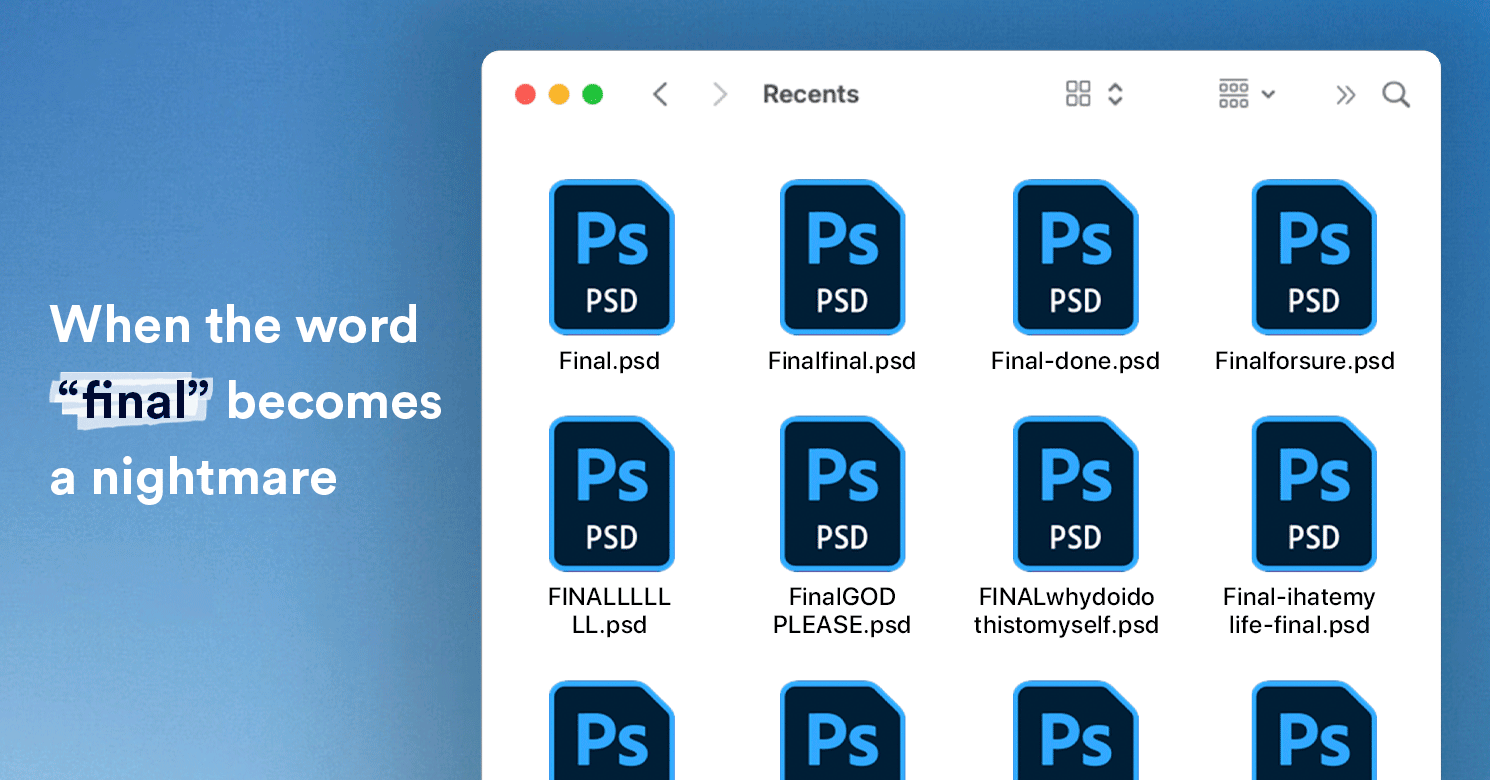The Top 3 Ways Marketing and Creative Handoffs Often Go Wrong: and How To Fix Them
Imagine: You’re creating incredibly impactful designs for your latest project and your marketing counterparts are crafting a seamless campaign journey. Everything is going smoothly. You’re closing in on the final file handoff when suddenly someone in marketing that you didn’t know was reviewing the work submits a very late piece of feedback with major copy updates. Even though you did your due diligence in making sure all of your deliverables were sized properly for channel placements and all text was laid out to avoid unsightly line breaks, and you've double-checked that all ratios comply with any platform requirements, it doesn't mean anything anymore. You didn’t have consolidated feedback from all the key project stakeholders, and guess who the only person able to make the necessary changes before launch is? That's you. Oof!
As a creative, you’ve likely been in a situation where information from your marketing counterparts has gotten lost in translation. It’s the age-old problem that happens time and time again: Information is relayed quickly, passed along to multiple team members, and along the way details are misconstrued, misinterpreted, or left out entirely. The result? Time and money are wasted. Not to mention the beautiful, creative concepts that are lost in the process.
In this post, we’re breaking down the top three ways marketing and creative handoffs often go wrong and how to fix them to improve your team’s collaboration and efficiency.

1. Lack of Clarity During The Project Kickoff
The Problem
Ah, the good ol’ project kickoff. This meeting sets the stage for the entirety of a project and has the opportunity to get everyone jazzed about their work. It also has the opportunity to fall flat and quickly spiral out of control.
We’ve all been there: You’re called into a project kickoff meeting and can immediately feel that your marketing team is under pressure. Another department or pesky client is putting the pressure on, and marketing is looking to you to deliver quickly. The creative brief is missing some vital background information, the timeline is unrealistic given everything else you have on your plate, and some important stakeholders weren’t invited to the meeting.
How It Can Spiral
In an effort to be a helpful team member, you sit back and say, “Sure thing, I can make this work,” all the while knowing you’re digging your own grave. Those missing details in the brief quickly lead to gaping holes of vital information you know you need in order to be successful, but the timeline is unrealistically quick, so you charge on and make educated guesses where you can. You’ve been put into a corner with prescribed ideas, so you do your best to make it work even though you know your work is not truly up to your creative standards.
You wrap up another late night getting everything in line for the R1 internal review, only to receive lackluster feedback from the team. That missing information from the project kickoff was actually pretty vital, and now you’re even further behind.
Uncomfortable yet? Having worked in the creative space, chances are you’ve likely encountered some version of this story. But not to worry, we’re here to help identify some tips and tricks to make sure you’re armed and ready for future project kickoffs.
Tips & Tricks
As you probably know all too well, there is immense value in a well-crafted creative brief. And while we know that in the majority of cases, marketing owns the task of filling out the brief leading up to the project kickoff, we’re here to recommend that as a creative, you make sure your voice is heard around what information is missing. Whether you’re new to an organization or a seasoned vet, it’s never too late to suggest process improvements.
Are you satisfied with the creative brief template your organization uses today? If you’re running into repeat issues or gaps in information, we recommend you take a look at how it can be improved. While you may not be the person filling the brief out, you certainly can be part of determining the necessary components.
We’re firm believers that for a creative brief to be truly effective, all team members (including any potential freelancers and outside agencies) should be able to easily understand the following:
- Campaign background and objectives
- The primary message that needs to be communicated
- Key challenges the campaign aims to solve
- Target audience
- Relevant competitor work
- Brand voice
- Communication channels (and the exact specs needed for placements)
- What success looks like and any mandatory elements to be included
- Helpful creative references or inspiration examples
- The timeline and length of steps in the process
- Key project stakeholders and roles for the project (approver, contributor, etc.)
The second vital part of this equation is developing a strong meeting agenda for all project kickoffs. As we’ve touched on, the kickoff meeting sets the stage for the project, so it is crucial that as creatives you ensure the right stakeholders are in the room to help answer questions and provide insights. We encourage you to start with this step for every kickoff meeting. If the correct stakeholders aren’t in the room, suggest that the kickoff be rescheduled. Otherwise, everyone’s time is being wasted. Additionally, we can’t stress enough how important it is to set aside time to clarify any questions that you might have. If you have questions or concerns about anything in the creative brief, now is the time to voice them!

2. Inconsistent Feedback During Reviews and Approvals
The Problem
The next critical handoff point for creatives and marketers is during review and approval discussions. While the kickoff meeting sets the stage for the entirety of a project, review and approval discussions determine which direction a project will take.
Your organization doesn’t have a set structure for how they provide feedback to your creative team. Feedback is sometimes written up in a lengthy email thread and other times sent in one-off messages via Slack or Teams, making it incredibly easy for you and your creative counterparts to lose track of important details. And the real icing on the cake is when you receive conflicting feedback from multiple stakeholders. This happens frequently, leaving you unclear on which direction to take.
How It Can Spiral
As with just about anything in life, a lack of organized feedback makes it easy to lose control. You’re juggling a bunch of projects so you quickly pull the feedback provided via Slack and also reference the lengthy email thread. The information isn’t consistent, so you pull pieces of each and charge on. In an effort to keep the project moving, you make a few educated guesses along the way based on the information provided. After all, we have to hit the deadline, right?
Everything seems like it’s moving in the right direction until you share the revised creative with the team. Turns out you’ve pivoted in a direction that wasn’t in line with what they wanted. You did your best with the information you had, but the gaps and inconsistencies in feedback have led to a much larger problem. Your time has been wasted, and once again you’re behind schedule.
Tips & Tricks
Similar to the creative brief, there’s also immense value in a structured approach to providing feedback. While oftentimes creatives aren’t the ones providing the feedback, you can absolutely help determine and structure the best way for your team to approach this. Not to be a squeaky wheel, but please make sure your voice is heard!
If you’re consistently finding that your marketing team isn’t providing feedback in a clear and concise manner, we recommend that you help create a process that benefits both of your teams. For instance, you can work alongside your marketing team to create a feedback template that can be used for each project. Templates should be crafted to best serve your specific organization, but it can be helpful to include details such as:
- Which aspects of the creative do you like and why?
- Which aspects do you not like and why?
- Are there any important details missing from the brief?
- Do you have creative references to help better explain your feedback?
The goal of a template like this is to ensure that all feedback from your marketing team is consolidated into one document that is easy for you to reference and understand, ideally leaving absolutely nothing up to interpretation. It’s also important to remember that as a creative, you’re allowed to provide feedback, too! Time and space should be made to talk through review comments with your marketing counterparts.
The second important part of all review and approval discussions is making sure that all necessary stakeholders have reviewed your work before providing their feedback. As we noted in the creative brief outline, we think it’s absolutely vital to have an understanding of who the stakeholders are at the very beginning of a project. This way you understand the chain of command and who will be responsible for providing final approval. When these decisions are taken care of early on, there’s zero ambiguity as to each team member’s roles and responsibilities.
During feedback discussions, don’t be afraid to ask your marketing team if all key stakeholders have had a chance to review the creative. If feedback notes are provided in a jumbled manner from multiple sources, ask someone on marketing to consolidate it in one place and ensure that all stakeholders are able to review one another's feedback. Be an advocate for yourself and your work by helping the entire team understand who has the final sign-off, whose buy-in is required, and what the proper way is for feedback to be shared.

3. Disorganization During Final File Handoff
The Problem
The last but certainly not least critical handoff for creatives and marketers is the final file handoff. While review and approval discussions determine which direction a project will take, the final file handoff determines the life of your creative — where it will live, who will be able to find it, and whether it’s ever used again.
We’re sure you’ve been here before: It’s 10 pm and you’ve been working tirelessly to finalize the creative for a campaign that launches tomorrow. You’re exhausted and fed up that you’re working another late night, so you wrap up the files and quickly send them to your team via Slack. The final file then lives in your Slack thread until it fades into the abyss, never to be seen again. You finished the project and sent off the files, so your job is done, right?
How It Can Spiral
Not so fast — you forgot to label and organize your final files, so things start to get a bit messy. As time goes on and final file handoffs continue in this manner, marketing can’t keep track of which creative has already been developed by your team. In an effort to stay organized, your marketing team will sometimes upload files to a shared drive, but there isn’t a consistent approach, which leads to a folder full of outdated files and multiple assets labeled “final.”

The longer this problem goes on, the bigger and scarier it gets. You start re-creating assets that you’ve already made because your teammates either can’t find what they need or simply can’t remember if it was already created. And unfortunately, you’re not organized enough to have the answers. This leaves your team, as well as sales and various other departments, without a place to access creative assets when they need them, so they find themselves searching for your company logo or other branded assets on Google. The worst part? This leads to outdated, off-brand materials being used out in the wild without your knowledge. Eek!
Tips & Tricks
Not to worry, thankfully there is a better way to approach the final file handoff so you can be sure your creative will live a long life. While our first two handoff points typically begin in the hands of the marketer, this one is completely in your team’s control. The No. 1 way to ensure that you have a successful final file handoff is to create a single source of truth: Imagine a place where all your team members could confidently access the latest and greatest approved assets you’ve made. Sounds like heaven, right?
However your team chooses to organize your assets, we believe that, above all, it should be easy. Our team recommends considering a digital asset management (DAM) system. Never heard of a DAM? We’ve got you covered.
A DAM system is designed to centrally store and manage all of your digital content. DAMs organize your final assets in a way that maximizes their value by allowing you to set expiration dates, determine access levels for different team members, and even tag your files so they’re easier to find. When files are stored across Slack channels, emails and shared drives, they often end up going to waste. Digital asset management systems ensure that your creative lives a long and healthy life.
Some DAM systems even allow you to mark assets as “under review” until you’ve received the final approval from your key stakeholders. Once assets are approved and have the green light, they can be easily shared and tracked so you can see how often they’re being used. These systems also allow for easy searchability so your marketing and sales teams are able to confirm a file doesn’t already exist before submitting a request.
Curious to learn more about how digital asset management can help keep your team organized? Check this out!
Effective Handoffs Drive Creative Impact
As a creative, you’re well aware that you bring a huge amount of value to your marketing team and organization. However, you need the right tools and resources in order to do your job to the best of your ability, which includes having the proper approach to working alongside your marketing team. Creatives are so frequently on the receiving end of handoffs, but there are a number of helpful ways you can facilitate a more productive design process for you and your team.
While it’s inevitable that there will be speed bumps along the way, we’re confident that your marketing team will genuinely appreciate any process recommendations you bring to the table. The combination of productive project kickoffs, clear reviews and approval discussions, and organized final file handoffs has the potential to elevate your team’s creative impact to an entirely new level.
Interested in learning more about how you can maintain creative control without making marketing enemies?

